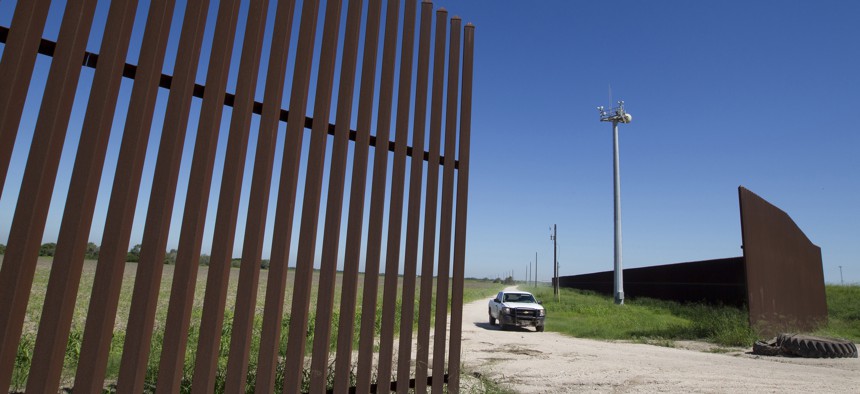
Donna Burton/Customs and Border Protection file photo
The Firm That Built the Border Fence Isn't Interested in the Border Wall
At least not yet.
Late on Thursday afternoon, the U.S. Customs and Border Protection agency announced that it will delay its plans to select a design for the border wall with Mexico. While vendors looking to build President Donald Trump’s wall had anticipated that request for proposals to be released on Wednesday, it now won’t drop before March 15.
It’s another minor delay for a process that has already hit a few stumbling blocks. On Tuesday, Senator Claire McCaskill, the top Democrat on the Senate Homeland Security Committee, sent a letter to Homeland Security Secretary John Kelly asking for information about prototypes for the wall. Her 16-point questionnaire calls for detailed answers on the acquisition and funding process: everything from the department’s permission to use existing funds for this job to “the level of IT security risk that DHS has assigned to this acquisition.”
McCaskill’s letter exposes how little detail the Customs and Border Protection agency has issued in its advance notice for a prototype design for the wall. No one knows who will pay for it, since Mexico insists that it will not and Congress has appropriated no funds for it. Indeed, an update posted Monday seemed to indicate the whole process was more of a design contest than anything.
“The intent of this procurement is to acquire and evaluate available wall prototypes and provide some initial construction of some wall segments, but is not intended as the vehicle for the procurement of the total wall solution for the border with Mexico,” the government said in its call for designs.
Monday’s update also cleared up some lingering questions about what makes a wall. CBP says that the agency “anticipate[s]” concrete wall structures, “nominally 30 feet tall”—in other words, a wall, not a fence. Building an honest-to-goodness concrete wall across some measure of the 2,000-mile-long border with Mexico—even one that falls short of Trump’s wildest dreams—will mean an enormous contract.
Hiccups explaining the wall to builders might help to explain why no global construction or engineering firm has expressed an official interest in the bid. More than 350 companies across the U.S. have thrown their business cards in the fishbowl, but the firms with the significant experience needed for the job—defense contractors, international project-management firms, and multinational engineering companies—have so far steered clear.
That’s not to say that none of them will answer the formal RFP once it’s released. Any and all of them could do so eventually. But several qualified firms who previously expressed an interest have since dropped out, including Leo A Daly and Raytheon.
One notable absence from the list of vendors is Michael Baker International. The global engineering company may have more direct and relevant experience for building a wall than any other firm in the world: Michael Baker built the fence that currently runs along the border.
Michael Baker won the bid to build the U.S.–Mexico border fence authorized by the Secure Fence Act of 2006. This legislation called for 225 miles of border fence, 300 miles of vehicle fence, and 70 miles of anti-personal barriers in stretches running from Texas to California. “Together, the initiatives represented the largest single CBP tactical infrastructure project in U.S. history,” the firm’s project description reads.
A spokesperson for Michael Baker responded to questions about the company’s plans with regard to the new wall with a statement:
Michael Baker International has supported the U.S. Government worldwide for more than 70 years, including as the lead engineer for programming, planning, execution and construction support for the U.S. Southern border in conjunction with the 2006 Secure Fence Act. Michael Baker also provides solutions for the U.S. Northern border as well as airports, shipping ports and other points of entry. Our border protection work spans three presidents and has allowed Michael Baker to contribute to the safety and security of the United States. We remain committed to continuing to support the U.S. Government in various critical capacities.
The firm declined to further discuss its work building the existing fence, the bidding process that led to that commission, or its reasons for not joining a list of vendors interested in building the next border wall.
If Michael Baker expressed any interest in designing the border wall, the firm would almost certainly be catapulted into the finalist category that is still TBD. Building the border fence was not one project but rather more than 50 different infrastructure projects, for which the firm oversaw logistics, designs, calculations, and other services provided by a phalanx of contractors.
While the firm has not ruled out this work, it has not indicated even in a passive way a real interest in pursuing this bid. Congress doesn’t support the border wall (yet, anyway). Voters do not support the border wall (according to recent polls). Builders, it seems—the ones that could actually build it—are at best on the fence.






